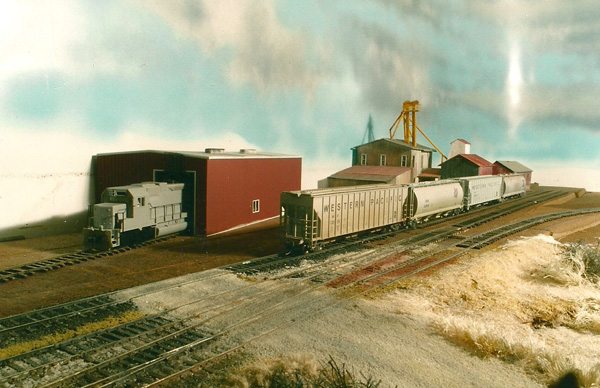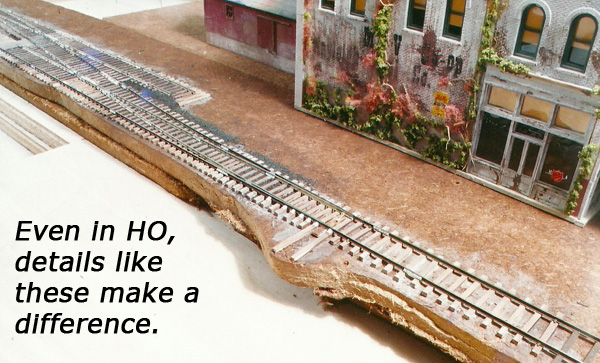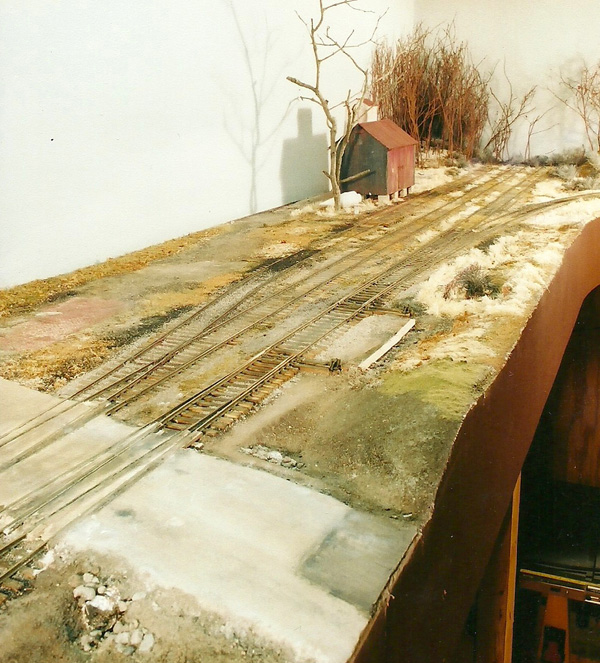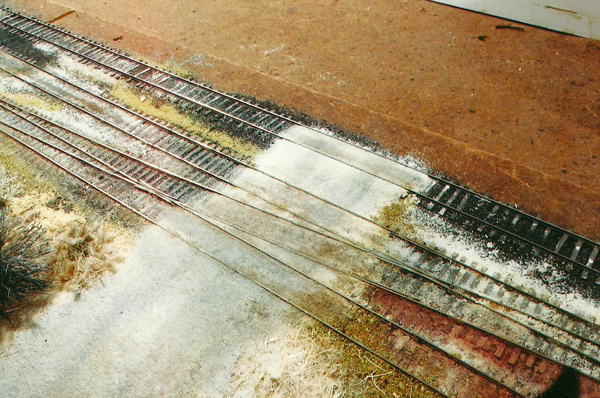If you keep doing the same things, you’ll get the same outcomes.
I’m convinced there is a certain size of layout that we’ll be happy with once we find it. Call it a freedom layout, one that provides just the right amount of interest and challenge without taking over your entire life. The problem lies in finding it. The general hobby isn’t going to be much help. It’s too married to the idea of more and more. Is that the best we can offer to each other and people looking at our hobby? If it is, we’ve derailed and piled up in the ditch big time.
Every large layout I ever attempted reached a certain percentage of completion before I got bored and trashed it. After an obscene number of these false starts, I finally realized I should be focusing on a much smaller layout and quit trying to single-handedly fill in the hole known as our town landfill. This seems blatantly obvious now but it took a long time for me to wake up.
Prior to adopting the Indiana and Ohio branch line as my prototype (a theme that has inspired layouts in two scales), I planned a monstrosity of a project based on the PRR in my hometown. I had a trackplan drawn up that was an exact scale replica of the trackage from the west end of Glen Yard through the depot, to the interlocking at Newman Tower and the bridge over the Whitewater River, a plan that included many landmarks of tremendous sentimental and emotional value from my childhood. Then the scope of what I was planning hit me hard. In fact, it scared the crap out of me. I was in my mid-forties and knew down to the marrow of my bones I would never finish this Frankenstein layout.
Why am I doing this?
Something clicked down deep and I realized I didn’t want to finance and build a 1/87th sized railroad themed amusement park to entertain all the people required to fully realize the operations potential of a PRR secondary main.
I really wanted something I could build, maintain and enjoy by myself. I also wanted to find a prototype close to home that I could leisurely study in-depth. The I&O provided for both criteria but I still had a ton of old thinking to shed.
I started anew with a basement sized HO rendition of the entire line from Valley Jct. to Brookville. It faithfully included the major towns and landmark scenes in a relaxed, uncluttered manner. This should have been a great layout, but it was never finished. Reason? In spite of the simple nature of the design, it was too big and I got bored with it. (See the last line in the paragraph above.)
A little of this, a little of that.
Subsequent attempts, also in HO, eventually resulted in a reduced layout size, which consisted of a 16″ wide shelf along one of the 24′ long walls of the basement, a precursor to the current layout. There were actually two different layouts of this size, both switching operations that included the shingle plant and Cedar Grove mill. Either of these should have also been a satisfying design, and would have been if I knew then what I do now about prototype operations. Since I didn’t know, there was always this nagging feeling that such a small, simple design wouldn’t provide enough operational “interest” whatever that was supposed to mean. Therefore, “feature creep,” or the temptation to constantly add other elements (I also really like grain elevators, urban street trackage, etc.) pushed both layouts into something unrecognizable from the prototype.

My last HO layout effort. This is in the same location as the town of Sycamore on the current layout.
My modeling philosophy also changed. The HO layout shown here (my last in HO) used P87 wheel and track standards. This move to finer standards proved very satisfying. I’ve always wanted to model track as faithfully as possible and on this layout I stepped up by including joint bars and turnout details from Details West. Even in HO these made a huge difference in the appearance of the track. While I used Micro Engineering code 70 flex track for regular trackage, I handlaid the turnouts in order to get the proper P87 flangeway dimensions and point spacing. It was also on this layout I began using much longer turnouts like No. 10s and 12s. They looked beautiful and watching equipment roll through was a joy. In my experience, building to P87 standards was no more difficult than using coarse RP25 specs. I even built a No. 10 self-guarded frog from code 70 and 83 rail sections and it worked beautifully.

Details West track items added a lot to this scratchbuilt No.12 crossover using code 70 rail and P87 standards.
20/20 rearview mirror
So what went wrong? Well, in hindsight, a lack of focus and genuine understanding of how the prototype actually worked drove the feature creep. I studied the branch for modeling subjects but hardly ever caught a train working Brookville or VJ. Since I couldn’t study operations first hand, I relied on the prevailing hobby ideas for how things are supposed to be done: hence the constant additions of other industries and “switching opportunities.”
In many ways I think that HO scale encourages feature creep because of its size. Nature abhors empty space and model railroading, at least as practiced in this country, abhors simple layout designs. HO scale is in the sweet spot for both syndromes in my view. However, what really pushed me over the edge was the difficulty in HO of modeling the level of detail I wanted. The limitations of the scale were becoming a serious liability for my aging eyes and less nimble fingers. When I had to use two types of magnifiers simultaneously to see what I was doing, it became too much. Something had to give.
To paraphrase Goldilocks: “This scale is just right!”
I dabbled in quarter-inch scale back in the mid 1970s and liked it a lot. I still had that equipment and began looking it over again, even going so far as to place it on the incomplete HO layout to get an idea of what I could do in the larger scale. I was very interested in P48 and if I could do what I wanted to do in P48, it would be an easy choice. No surprise here since I was already using P87 standards. The tipping point came when I met other P48 modelers and saw the possibilities firsthand. They helped me get oriented to what was available in quarter-inch scale and where to find things. One day I’d had enough waffling. I walked in and just started dismantling the old HO layout. It was stripped down to empty benchwork in less than an hour. (Hey honey, I’m going to the landfill.) It took time to adjust my thinking to the size differences between 1/87 and 1/48. Once I got rid of the HO elements, I could more accurately envision how the larger scale would fit the space. The rest, as they say is history.
A freedom layout: 1. A layout sized no bigger than required to provide ongoing interest and modeling challenges. 2. One that fits into your life instead of taking over your life in the process of building it.
Most people see the size of quarter-inch scale models as a huge liability. I’ve learned it’s a blessing of the first order. The scale makes you prioritize in terms of modeling choices. With the requirements of large radius curves for running typical mainline equipment (think of a 48″ radius as a bare minimum and go up -way up- from that), one simply won’t be able to include as much in a given space. For me the restraints the scale imposed supported the focus I needed to see this layout to completion and, it has proven to be the right size for my interest level and tolerance for construction time before boredom sets in. There are plenty of challenges left to explore even though the layout looks finished to the casual visitor. It’s all a matter of mindset. I enjoy this layout more than any other I’ve attempted in the past because it doesn’t dominate my life. It’s there when I want to work on it and, the compulsion to finish it simply doesn’t exist like it does with the sacred cow lifetime layout.
A better route to freedom
Maybe I had to flounder around before reaching the point of maturity and focus with the hobby I’m at now. Maybe we all take this route in some form. I don’t think it has to be this way. It’s just gotten this way by default. There has to be a better process of discovery. Asking better questions in order to find better answers is what this blog and OST Publications Inc. is all about.
Regards,
Mike


This sums up nicely what I have been thinking about for a few years now. I’ve already started moving in this direction and I think calling it a freedom layout is great. I’ve certainly felt more free with my new simplified/focused modeling efforts.
-Jim
Welcome to the blog Jim. Nice to have you here. I’m glad you found a direction that works for you. One size doesn’t fit all as you’ve experienced.
Regards,
Mike Cougill
Been going through the same thought process recently. Glad not to be alone – although I wish I had found this site (and Trevor’s!) sooner.
Simon Dunkley
Hi Simon,
Well you’re here now and, I’m glad to know that the posts are helpful.
Regards,
Mike
While it may seem counter intuitive, I think another alternative HO detailing madness for aging eyes and declining dexterity is to go smaller (i.e., N scale) rather than larger (i.e., O scale). The 100 detail parts on a HO scale freight car are simply too small to be seen by any eye and can be ignored. N scale emphasizes the “big scene”. Trains are observed in a larger context and viewer attention is directed to whole scene rather than focusing on an individual piece of rolling stock or structure. N scale structures and scenery features don’t require as much selective compression and may consume a greater volume of layout space. Hence, I think N scale would be very compatible with your less is more concept.
Jerry
Hi Jerry,
Welcome to the blog.
Being a natural detail freak, I hadn’t considered this approach but, you’re absolutely right. Yes, going smaller is counter-intuitive to the reasons I gave for moving to quarter-inch scale, however it makes sense if you prefer a big picture approach rather than a focus on fine details. We each have our natural and preferred inclinations. Thanks for the input.
Most appreciated,
Mike